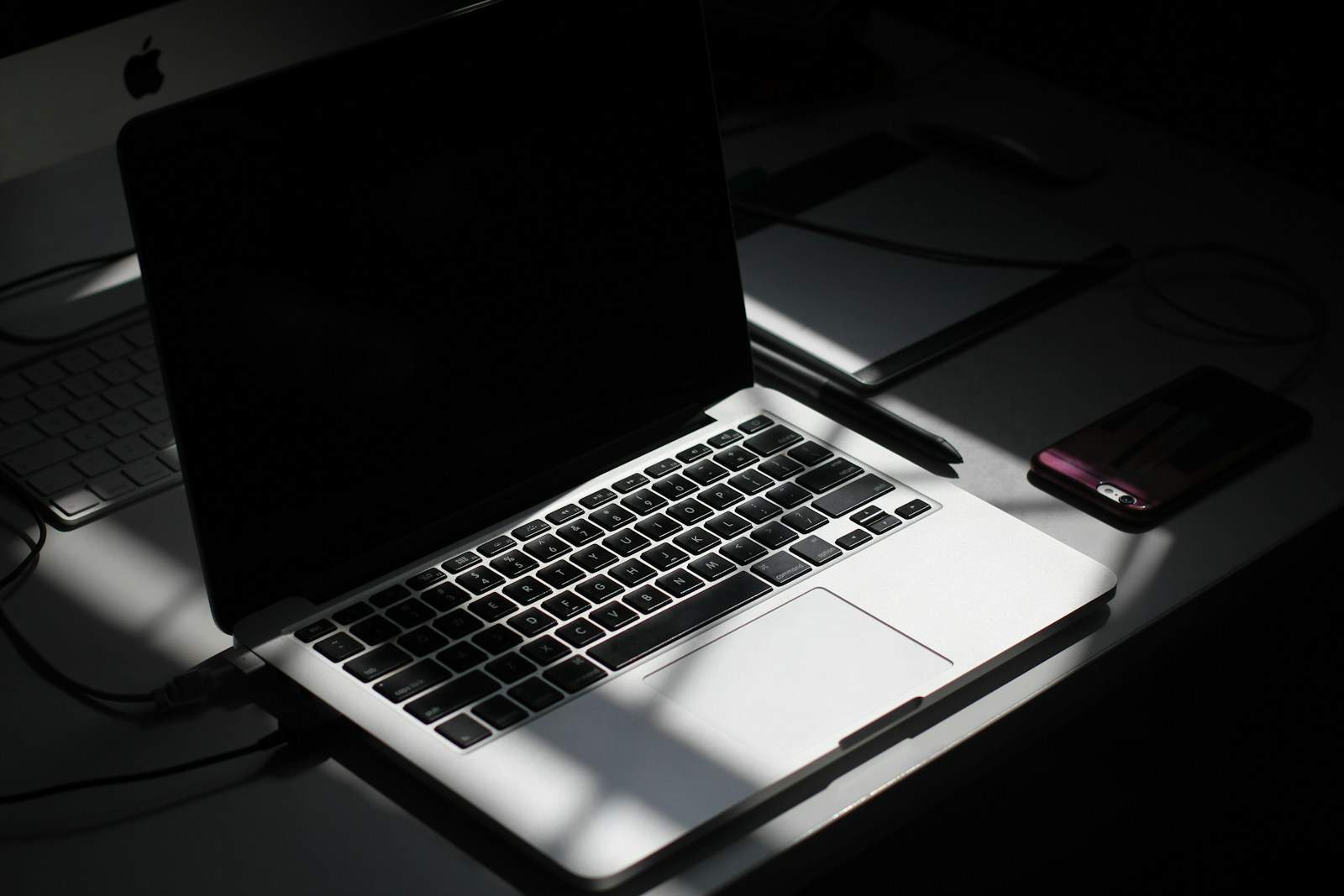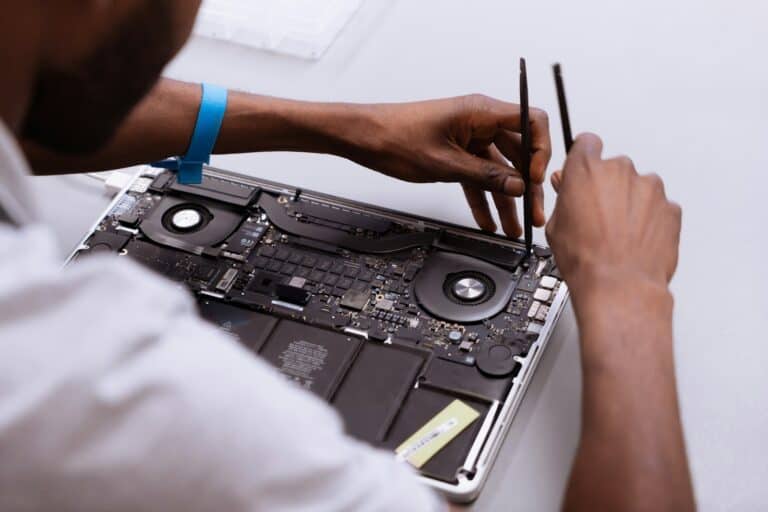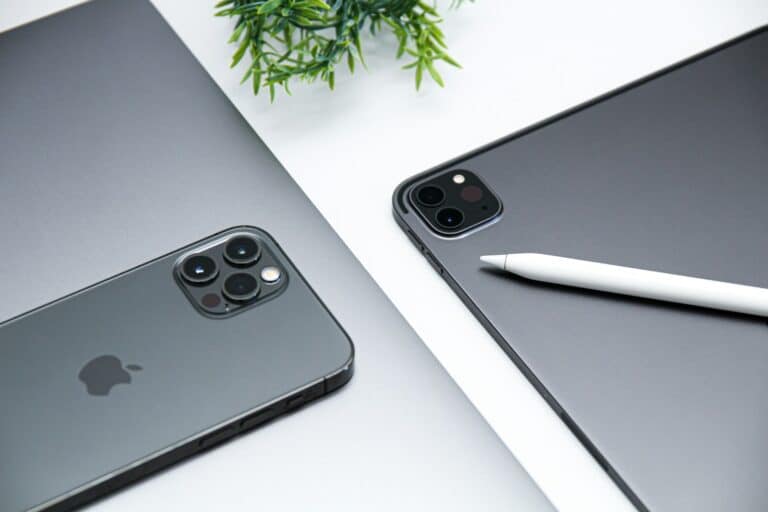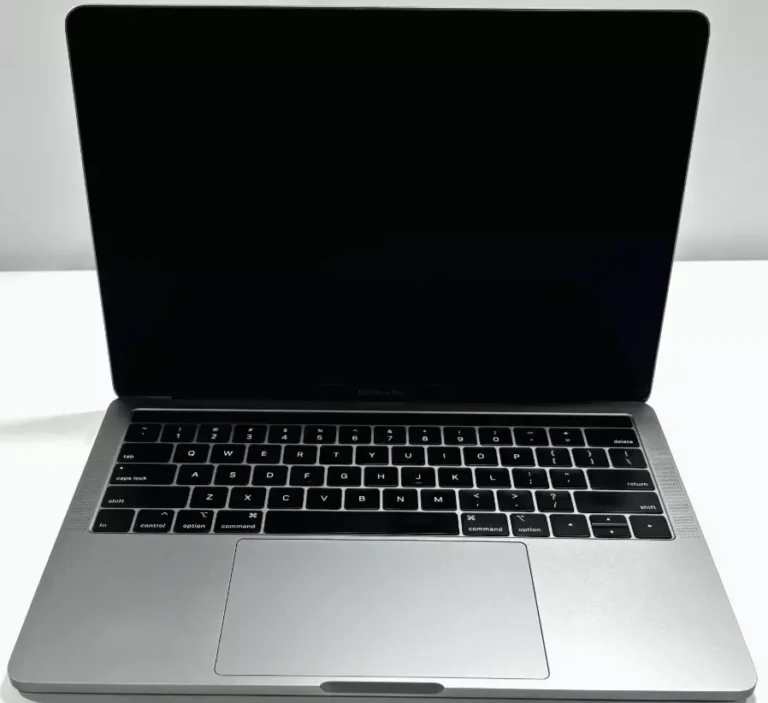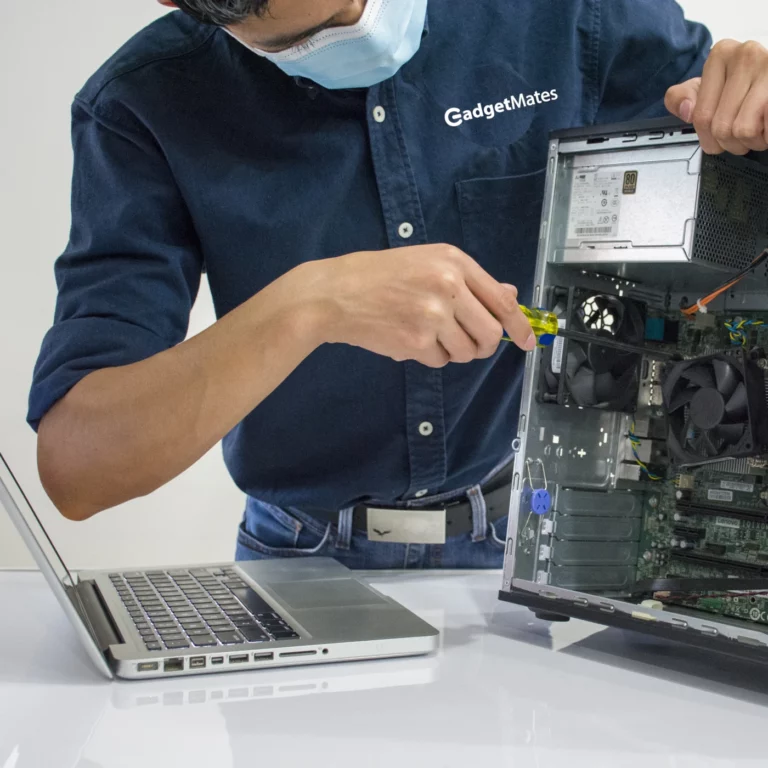When a MacBook won’t turn on, it’s a big hassle and can disrupt your work. There could be different reasons for this problem, from simple power issues to complex hardware failures. First, check the power connection and make sure the battery isn’t dead. If that doesn’t work, you might need to try more advanced methods like fixing the software or checking the hardware. Sometimes, simple solutions like doing a power cycle can help.
Press and hold the power button for a bit to fix problems with the MacBook being stuck in sleep mode. Also, strange software problems can stop the MacBook from starting up. You might be able to fix these by starting the MacBook in a special mode or doing software updates. If nothing works, you might need to have the hardware checked or get professional help. It’s also really important to back up your important info before you try anything fancy.
Initial Assessment
Before diving into solutions, understand that a MacBook that won’t turn on could be experiencing issues ranging from a simple drained battery to more complex hardware malfunctions (source: TechBloat).
Step 1: Check Power Connections
For MacBooks with built-in displays:
- Ensure your power cable is undamaged and plugged securely into your MacBook
- Verify the power adapter is connected to a working electrical outlet
- Try a different power outlet to rule out electrical issues
- If available, test with another compatible power cable or adapter (source: Apple Support)
For Mac desktops:
- Check that your external display is connected to power and turned on
- Verify all display cables are securely connected (source: Apple Support)
Step 2: Perform a Power Cycle
- Disconnect the power adapter completely
- Hold the power button for 10 seconds to drain any residual power
- Wait 5 minutes before reconnecting the power adapter
- Press the power button to attempt startup
Step 3: Check for Signs of Life
Look for these indicators that your MacBook is receiving power:
- LED indicator on the power adapter (should glow when connected)
- Charging light on the MacBook (if applicable to your model)
- Fan noise or hard drive spinning sounds
- Any brief screen illumination
Step 4: Reset the System Management Controller (SMC)
The SMC controls power-related functions. Resetting it can resolve many power issues:
For MacBooks with removable batteries:
- Shut down the MacBook
- Remove the battery
- Hold the power button for 5 seconds
- Reinstall the battery and power adapter
- Turn on the MacBook
For MacBooks with non-removable batteries:
- Shut down the MacBook
- Hold Shift + Control + Option + Power button for 10 seconds
- Release all keys simultaneously
- Press the power button to turn on
Step 5: Force a Mac to Start
If your Mac shows no response, try forcing it to start:
- Press and hold the power button for 10 seconds
- Release and wait a few seconds
- Press the power button again normally (source: Macworld)
Step 6: Address Battery Issues
For a completely drained battery:
- Connect the power adapter and wait at least 30 minutes before attempting to turn on
- Some MacBooks won’t respond immediately when the battery is completely depleted
- Look for charging indicators after 15-30 minutes of charging (source: SimplyMac)
Step 7: Boot in Safe Mode
If your MacBook shows signs of power but won’t complete startup:
- Press the power button
- Immediately hold the Shift key until you see the login screen
- This loads only essential system files and may bypass software issues
Step 8: Hardware Diagnostics
If software solutions don’t work, run Apple Diagnostics:
- Disconnect all external devices except power adapter
- Hold the D key while pressing the power button
- Follow on-screen instructions to test hardware components
When to Seek Professional Help
Consider professional repair services if:
- None of the above solutions work
- You notice physical damage to the power adapter or MacBook
- The MacBook is making unusual noises
- There are signs of liquid damage
- Your MacBook is still under warranty
Professional repair may be needed for issues like failed logic boards, damaged charging ports, or defective batteries (source: iFixit).
Prevention Tips
- Avoid completely draining your battery regularly
- Keep your MacBook in moderate temperatures
- Use only genuine Apple power adapters when possible
- Perform regular software updates to prevent system conflicts
Conclusion
Most MacBook power issues can be resolved with these troubleshooting steps, starting with the simplest solutions first. The key is to work systematically through each step before concluding that professional repair is needed (source: Digital Procrest). Remember that patience is important—some solutions, particularly battery-related ones, may take time to show results.
Power Up Your Mac: Troubleshooting Tips
Check Your Power Connections
First things first, make sure your MacBook is plugged in properly. Double-check the connection between the charger and your laptop, as well as the outlet. If you’re using a power strip or surge protector, try plugging your charger directly into the wall.
Inspect Your Charger
Look closely at your charger for any signs of damage, such as frayed wires or a bent prong. A damaged charger can prevent your MacBook from powering on. If you suspect a faulty charger, try using a different one or borrowing one from a friend to test it.
Reset the SMC (System Management Controller)
The SMC controls various power-related functions on your MacBook. Resetting it can often resolve power issues. The steps for resetting the SMC vary depending on your MacBook model, so refer to Apple’s support documentation for specific instructions.
Try a Different Outlet
Sometimes, the issue might be with the outlet you’re using. Try plugging your MacBook into a different outlet to see if that makes a difference. If you’re using a power strip, try plugging it into a different outlet as well.
Check for Signs of Life
Look for subtle signs that your MacBook might be getting power. Do you see any lights on the charger or your laptop? Can you hear the fan spinning? If you see or hear any signs of life, it suggests the issue might be with the display rather than the power supply.
Contact Apple Support
If you’ve tried all these steps and your MacBook still won’t turn on, it’s time to contact Apple Support for further assistance. They can help diagnose the problem and recommend solutions, such as a repair or replacement.
Additional Tips
- If your MacBook has a removable battery, try removing and reinserting it.
- Press and hold the power button for 10 seconds to force a restart.
- If you see an Apple logo or a spinning globe, your MacBook is attempting to start up. Be patient, as it may take some time to boot up fully.
If you’ve exhausted all troubleshooting options, don’t despair. Apple Support is there to help you get your MacBook back up and running.
MacBook Not Turning On Troubleshooting Table
| Possible Issue | Solutions |
|---|---|
| No power connection | * Check if the power cable is securely plugged into both the MacBook and a working electrical outlet. * Ensure the cable is undamaged. |
| MacBook not responding to power button press | * Press and hold the power button for 10 seconds, then release and press it again normally. |
| External display issue (for laptops without built-in display) | * Verify the external display is connected securely to the MacBook and a power source. * Ensure the external display is turned on. |
| Conflicting peripheral | * Disconnect all external accessories (except the power cable) from the MacBook and try turning it on again. |
| Startup issue (if you see something on the screen) | * The specific troubleshooting steps will depend on the symbol displayed on the screen. Refer to Apple Support for assistance: https://support.apple.com/en-us/102675 |
| Hardware issue (if you see nothing on the screen) | * For Intel-based Macs only: Try resetting the SMC (System Management Controller) by following Apple’s instructions: https://support.apple.com/et-ee/guide/mac-help/mh29198/mac * If the issue persists, contact Apple Support for further assistance. |
Additional Notes:
- It is important to follow the troubleshooting steps in the order listed, as some solutions may resolve the issue before you need to move on to the next one.
- If you are uncomfortable performing any of the troubleshooting steps, or if none of them resolve the issue, it is recommended to contact Apple Support for further assistance.
Key Takeaways
- Basic procedures include checking power connections and performing a power cycle.
- More complex issues may require starting in Recovery mode or software updates.
- If complications continue, assessing hardware components or professional repair services may be needed.
Initial Troubleshooting
When your MacBook does not turn on, the first steps involve checking the power supply and hardware connections. These initial checks can often resolve the most common power issues.
Check the Power Source
Ensure that your MacBook is connected to a power source. Verify that the power outlet is functioning by testing it with another device. If the outlet is operational but the MacBook still does not power on, proceed to inspect the power cable and adapter.
Inspect the Power Cable and Adapter
Examine the power cable and adapter for any signs of damage, such as fraying or breaks. Confirm that the connection between the power cable and the MacBook is secure. The MagSafe connector should show an LED indicator light; amber signifies charging, and green indicates a full charge.
Battery and Power Connection Check
On a MacBook with a non-removable battery, perform a power cycle by holding the power button for 10 seconds, then pressing it again as you normally would to turn on the device. For MacBooks with a removable battery, disconnect the battery and then attempt to power on the MacBook with the charger connected. This can sometimes reset the power connection and resolve startup issues. If the MacBook still fails to turn on, further investigation or professional assistance may be required.
Basic Reset Procedures
Before attempting more complex troubleshooting steps, MacBook users can often resolve issues with their devices not turning on by performing basic reset procedures on the System Management Controller and NVRAM or PRAM.
Reset the System Management Controller (SMC)
The System Management Controller (SMC) is a crucial component in Intel-based Mac computers, including MacBook Pro, MacBook Air, and Mac mini models. If your Mac is exhibiting power-related issues, resetting the SMC might resolve them. The steps vary slightly depending on whether the Mac has a removable battery, a non-removable battery, or the Mac is a desktop model.
For MacBook models with a non-removable battery:
- Shut down the Mac.
- Press and hold the Shift + Control + Option keys on the left side of the keyboard and the power button simultaneously for 10 seconds.
- Release all keys and the power button at the same time.
- Press the power button to turn on the Mac.
For desktop Macs like the iMac or Mac mini:
- Unplug the power cord.
- Wait 15 seconds.
- Plug the power cord back in.
- Wait 5 seconds, then press the power button to turn on the device.
Reset the NVRAM or PRAM
NVRAM (Non-Volatile Random-Access Memory) and PRAM (Parameter RAM) store specific settings that a Mac uses during startup. Intel-based Macs use NVRAM, while older Macs use PRAM.
To reset the NVRAM on an Intel-based Mac:
- Shut down the computer.
- Locate the Command + Option + P + R keys.
- Turn on the Mac.
- Immediately press and hold the identified keys for about 20 seconds. The Mac may appear to restart.
- Release the keys after the second startup sound or after the Apple logo appears and disappears for the second time.
Note: When you reset the NVRAM or PRAM, settings such as sound volume, display resolution, startup disk selection, and time zone may be reset.
Software Checks and Recovery
When your MacBook does not turn on, it’s essential to explore software-related issues that could be preventing it from booting correctly. The following subsections provide targeted steps to diagnose and potentially resolve the problem.
Boot in Safe Mode
To initiate Safe Mode, restart your MacBook. Immediately press and hold the Shift key as it boots. This process conducts a check of your startup disk and only loads essential software, which can often resolve issues related to booting.
Verify and Repair Disk Utility
From Safe Mode or Recovery Mode, you can access Disk Utility to verify and repair your disk. With your MacBook powered off, press and hold the Command + R keys upon startup to enter Recovery Mode. Then select Disk Utility to inspect the startup disk for errors and attempt repairs if necessary.
Use Recovery Mode Options
Recovery Mode also provides options to restore from a Time Machine backup or reinstall macOS. If the aforementioned steps fail, these options may rectify underlying software issues. While in Recovery Mode, you can choose to restore your MacBook to a previous state with Time Machine or reinstall macOS, which will install a fresh copy of the operating system while keeping your files intact. Ensure you’ve selected the proper startup disk before proceeding with these recovery actions.
Assessing Hardware Issues
When a MacBook does not turn on, hardware components should be scrutinized systematically to identify any faults that may be preventing the machine from booting up.
Examine External Peripherals
Firstly, disconnect all external devices from the MacBook to rule out peripheral interference. This includes USB devices, Thunderbolt docks, external displays, FireWire accessories, and even printers. After removing these items, attempt to turn on the MacBook again. If the computer boots up, reconnect each device individually to isolate the issue.
Listen for Startup Sounds and Check Display
Press the power button and listen carefully for any startup sounds. The absence of the startup chime or other sounds could indicate a malfunction. Simultaneously, inspect the display for the Apple logo or any signs of life, such as a faint image or backlight. If the MacBook has an M1 chip, ascertain that the machine is receiving power and the display remains blank prior to concluding that service may be required.
Internal Hardware Diagnostics
If the external checks yield no results, move to internal diagnostics. Start by examining the hard drive for any unusual noises that may suggest a failure. On MacBooks with Apple silicon, such as those with an M1 chip, pressing the power button should trigger the boot-up process, if the hard drive is functional. If the screen stays dark and no startup sounds are evident after these steps, the MacBook’s internal hardware could be at fault and professional support from Apple or an authorized service provider might be necessary.
Professional Help and Repair
When a MacBook does not turn on, and all self-help troubleshooting steps have failed, seeking professional assistance is the next recommended step.
Utilizing Apple’s Genius Bar
The Genius Bar is Apple Store’s in-house tech support service. Booking an appointment is straightforward through the Apple Support website or the Apple Store app. At the Genius Bar, trained technicians called “Geniuses” perform inspections and can carry out repairs or suggest replacement options. They will also inform customers about any applicable warranty coverage or provide a cost estimate if the warranty period has expired.
- Repair options at the Genius Bar may include:
- Diagnostic Tests: To precisely pinpoint the issue with the MacBook.
- Hardware Repairs: For problems with components like logic boards or batteries.
- Software Fixes: For non-hardware related issues that prevent startup.
Considering Authorized Service Providers
For those who cannot access an Apple Store, Apple has a network of Authorized Service Providers (ASP) equipped to handle MacBook repairs. These providers adhere to Apple’s stringent service standards and only use genuine Apple parts, ensuring quality and compatibility.
- Working with an Authorized Service Provider entails:
- Local Convenience: ASPs are often more numerous than Apple Stores, making them more accessible.
- Certified Technicians: Their technicians have been certified by Apple, ensuring reliable service.
- Warranty and Repair Options: Similar to the Genius Bar, they can inform you about warranty coverage and offer post-warranty repair services.
It is always recommended to seek service from certified professionals to maintain the integrity and longevity of your MacBook.
Backup and Data Management
When faced with a MacBook that won’t turn on, safeguarding data is a critical step. This section involves strategies for accessing and managing backups, ensuring the safety of your valuable information.
Accessing Time Machine Backups
Time Machine is a built-in backup utility for Macs that creates incremental backups of files that can be restored at a later date from an external drive or network drive. To access Time Machine backups:
- Connect the Time Machine backup drive to another Mac.
- Hold the Option key and click the Time Machine icon in the menu bar.
- Choose Browse Other Backup Disks.
- Select the backup you want to access, enter your password if prompted, and you can then view and restore specific files as needed.
Data Transfer to an External Drive
If your Mac won’t boot and you’re unable to use Time Machine, you can try using Target Disk Mode to transfer files to an external drive, provided you have an Intel-based Mac:
- Connect your Mac to another Mac using a Thunderbolt or FireWire cable.
- Start the non-responsive Mac and immediately hold down the T key to enter Target Disk Mode.
- The Mac’s hard drive will appear as an external drive on the other Mac.
- Files can be transferred to an external drive ensuring that important data is not lost.
Advanced Solutions and Resets
If the initial troubleshooting steps fail, exploring advanced solutions may be necessary. For Macs with non-removable batteries and potential logic board or power supply issues, specific resets can be crucial to reviving the system.
Recovery for Non-Removable Batteries
For Mac computers with non-removable batteries, such as the latest MacBook models featuring M1 chips, resetting the system management controller (SMC) can often resolve power-related issues.
- Reset SMC on an M1 Mac:
- Shut down the Mac.
- Press and hold the power button for 10 seconds.
- Release the button and wait a few seconds.
- Turn on the Mac by pressing the power button.
Logic Board or Power Supply Issues
When a Mac desktop computer, such as a Mac Mini or iMac, does not power on, the logic board or power supply might be at fault.
- Check Power Connections: Verify that the power cable is securely attached and the electrical outlet is functional.
- Perform a Power Cycle:
- Disconnect all power sources.
- Hold down the power button for 10 seconds.
- Reconnect the power cord and attempt to turn on the Mac.
If these actions fail to revive the desktop, further hardware assessment may be necessary, potentially requiring professional assistance.
Understanding Status Indicators
When your MacBook fails to turn on, understanding the status indicators can provide crucial clues to diagnosing the issue.
Evaluating LED Indicators
The Status Indicator Light (SIL) on your Mac is a key signal to interpret the device’s state. A healthy Mac in sleep mode will exhibit a pulsing light, which brightens and dims slowly. However, if the SIL is flashing, this may suggest a need for service. Specific LED behaviors are linked with various states:
- Solid Amber: Firmware recovery mode, which might necessitate a firmware revival on Macs with Apple silicon or an Apple T2 Security Chip.
- Rapidly Flashing Amber: Also indicates firmware recovery mode or possible hardware issues.
It is essential to observe the pattern of flashes or colors to take the appropriate troubleshooting steps.
Interpreting Onscreen Icons
When a Mac attempts to turn on but encounters issues, certain onscreen icons might appear, guiding users on the potential problem.
- Apple Logo: Signifies that the Mac is starting up. If the logo remains on screen without progress, it may be a software problem.
- Question Mark: Appears when the Mac can’t find the boot disk. This implies a problem with the startup disk or the operating system is not found.
- Progress Bar: Indicates ongoing system checks or software updates. Stalling during this process can suggest an update issue or software corruption.
- Blue Screen: If the startup process stops at a blue screen, this could signify a problem with startup items or peripherals.
- Login Window: Stopping at the login window without any responsiveness might signal issues with user accounts or software.
- Lock Icon: If prompted with a lock icon, this indicates the Mac requires a firmware password to proceed.
If you encounter any of these issues, running Diagnostics or accessing support material from Apple may be necessary to address the underlying software or firmware concerns.
Frequently Asked Questions
Troubleshooting a MacBook that won’t turn on can be stressful. This section outlines clear steps to diagnose and potentially solve power issues on your MacBook.
What steps should I follow if my MacBook is charged but won’t start?
First, check that the power cable and the adapter connections are secure and unharmed. If your MacBook is charged but won’t start, you may need to reset the System Management Controller (SMC), a process that can resolve issues related to power, battery, and other system functionalities.
How can I troubleshoot a MacBook that won’t turn on after the battery has completely drained?
For a MacBook that won’t turn on after its battery has completely drained, connect it to your charger and wait a few minutes before trying to turn it on. Ensure the charger is working and that the indicator light is on, signaling it’s receiving power.
What should I do when my MacBook shows no signs of power or charging?
Inspect the power cable and adapter for signs of damage. If there are no signs of power or charging, try using a different cable or adapter. If these components seem operational, the SMC reset mentioned earlier can be attempted next.
How can I force start my unresponsive MacBook?
To force start an unresponsive MacBook, hold the power button for ten seconds, then release it and press it again as you would to normally turn on the device. This can sometimes trigger the MacBook to start if it was previously unresponsive.
What are the solutions for a black screen on my MacBook despite it being powered on?
If your MacBook is turned on but shows a black screen, adjust the screen brightness or connect it to an external display to check if it’s a display issue. If there is no response, rebooting into Safe Mode by holding the Shift key during startup can help troubleshoot software conflicts that might cause the black screen.
What troubleshooting methods can I use for a MacBook that doesn’t respond to the power button?
If your MacBook does not respond to the power button, disconnect all peripherals and attempt a power cycle by holding down the power button for ten seconds. Afterward, reconnect the charger and try to power it on again. If the issue persists, seeking professional diagnostic services may be necessary.

